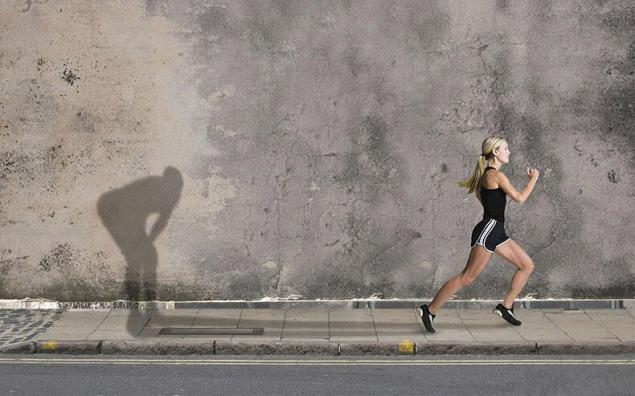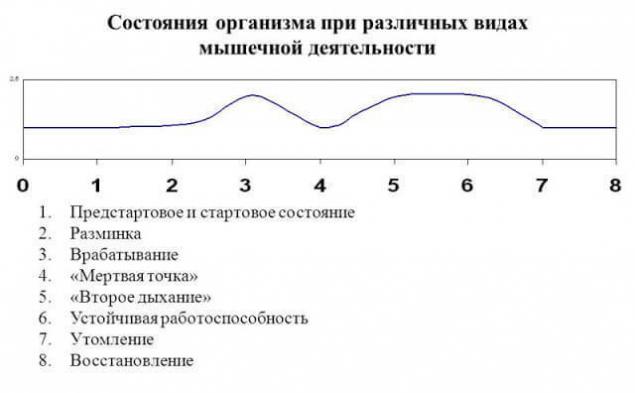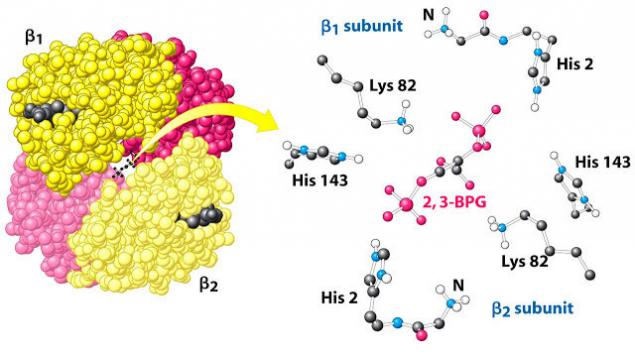832
How to escape from the deadlock and get a second wind
If a person without a warm-up immediately rushed to run, then it will soon start shortness of breath and palpitations. During fast running you did not just experienced an unpleasant feeling when the whole body as it is poured into a lead weight, wind spiral, and the heart is beating so hard that it seems, is about to jump out of my chest.
At such moments, and I want to lie down, stretch out full length and rest. But we have such a moment dumb when switched "second wind". However, if you continue to run on, then after some time the phenomenon of oxygen starvation are gradually disappearing, is set even breathing, heart rate decreases, and there is a so-called
«second wind." And sometimes there comes a "dead point" and it is very difficult to continue to run, and is it necessary? Sometimes a "second wind" is coming, and sometimes not, sometimes it is a good sign, sometimes bad. Let's look at the mechanisms of the "second breath" and "dead spots" at various levels.

"Blind Spot" and "second breath»
"Second Breath" - a physiological effect that manifests a significant increase in physical performance after a strong background of fatigue on performance of heavy load. For example during a marathon, "second wind" opens the second half of the race and finish time. I draw your attention that this phenomenon is characteristic of most untrained people, while professional athletes second breathing is practically not observed, because lactic acid is quickly destroyed and the muscles are not "acidifying" at the initial stage of the load.
It was also found that "second wind" comes the sooner, the better trained personnel. Second Wind is accompanied by a sense of physical relief, restoration of the normal activity of mental functions (memory, attention, thinking, perception), the advent of sthenic emotions, the desire to continue.
Dead point - the condition of the body under intense physical exercise. It occurs a few minutes after the start of intense muscular work. You receive an unpleasant sensation, accompanied by shortness of breath, chest tightness, dizziness, feeling of vascular pulsation in the head, the desire to stop working.
With prolonged use large, submaximal and sometimes moderate (average) intensity (in oxygen prompted more than 1,500 ml) may be a particular state of fatigue, accompanied by a sharp decline in performance. The dead point can be regarded as a condition of acute stress caused by physical work.
Signs of a state of "dead spots": frequent shallow breathing; large ventilation equivalent of oxygen; high heart rate; decrease in blood pH; significant sweating. This condition is associated with deterioration of mental functions: perception of declining clarity, there are illusions, especially in the field of musculo-motor perception, weakened memory (especially reproduction processes), thinking. Disturbed attention: its volume is reduced, lost distribution capacity is sharply reduced its stability. It slows the speed of the number of false responses and reactions increases.

Breathing, oxygen and a second wind.
The reason for the onset of the "dead point" is that at the beginning of your workout you need some time to get the cardiovascular system came to a certain level of operation, and was able to adequately supply the working muscles with oxygen. And at the beginning of the workout intensity over a mismatch between the needs of the muscles the oxygen and the ability of the cardiovascular system to adequately provide the body with oxygen. As a result, from the start to accumulate in muscle degradation products primarily lactic acid. Accordingly, in order to avoid a state of "deadlock" is necessary to gradually increase the intensity of your workout.
If the state is "dead spots" still occurred, it can be overcome by great willpower. If the physical work will continue, it will change the state of feeling sudden relief, which often manifests itself in the appearance of normal (comfortable) breathing. Therefore, the state system, replacing the "dead point" is called "second wind." The emergence of "second wind" means that the body has adapted to perform physical activity and is able to satisfy the working muscles in their energy queries.
It is shown that observed in the event of deadlock difficulty inhaling ( "interception of breath") is due to the narrowing of the gap between the vocal cords, which reduces the amount of air traversed when tachypnea through this gap and thereby reduces the irritation of receptors located in the ligaments.

Breathing is a process of continuous exchange of substances between the organism and the environment by means of inhalation and exhalation. Energy processes in normal breathing occur with the participation of oxygen (aerobic type of respiration). Meanwhile, during exercise, especially cyclic movements, repeating the same pace -.. Running, walking, skating, skiing, etc., energy processes can proceed without participation of oxygen (anaerobic respiration type), and the body works like on credit.
Athlete while running at a hundred meters takes 7 liters of oxygen, and it is time to breathe only 0, 3-0, 5 liters. Despite the increased respiratory rate, increased heart activity, the body in such a short time to ensure the demand for oxygen can not and therefore switches to the oxygen-free breath (anaerobic), working in the "debt", which is compensated by some time after apnea termination of loading and heartbeat.
Metabolism and load.
During physical activity significantly increased muscle work. The main source of energy for muscle tissue is the oxidation of glucose (glycolysis). Under normal conditions, there is oxidation of glucose with oxygen (aerobic glycolysis). In skeletal muscle intensive, with limited access of oxygen, oxidation vklyuchaetsyaanaerobnoe during which pyruvate (pyruvic acid) is converted into lactate (lactic acid) without oxygen consumption. This accumulation of lactic acid gives the clinical picture of tiredness, pain and burning sensation in the muscles.

Second Wind at the molecular level
Under the conditions of lack of oxygen in red blood cells formed a byproduct of glycolysis-2, 3-bisfosfoglitserat (BFG). BFG, joining hemoglobin, can change its affinity for O2.
In the center of the tetrameric hemoglobin molecule has a cavity formed by amino acid residues of the four protomers. The central cavity - a place BFG accession. Connections BFG calls it a conformational change in a way that reduces the affinity of hemoglobin for oxygen.
And it is better to diffuse to tissues. Increased flow of oxygen to the muscles needs aerobic anaerobic glycolysis in that 'burns' lactic acid in the Krebs cycle.

Red blood cells and their redistribution:. Pain in his side
"Second Breath" at the macro level is due to the ejection of blood from the depot and the increase in the yield of red blood cells from the bone marrow, spleen, liver, and skin, which increases blood oxygen capacity. When a person is at rest, a certain portion of the blood does not take an active part in the circulation and is "reserve". The main part of it is concentrated in the abdominal and thoracic cavities.
The liver and spleen tension during sudden physical stress plays an important role blood deposited in hollow veins. Worsens the problem of too frequent and shallow breathing. The aperture is thus reduced and almost negligible generates no additional vacuum in the chest cavity. Because of this, blood is not as strong as might be, coming from the liver and spleen in the vena cava.

This reserve in the event of physical activity "is taken in hand" for the needs of working muscles. Blood begins to overflow the abdominal organs as a result of certain physiological properties of its outflow "has no time" for a sharp inflow. The spleen and liver "swell" from the rush of blood and begin to put pressure on its shell (capsule), also with an increase in the level of stress hormones splenic capsule begins to shrink, releasing more blood into the blood (splenic capsule contains a lot of muscle cells).
In many places, particularly in the English Wikipedia it says that the exact cause of "a transient abdominal pain associated with exercise» (exercise related transient abdominal pain - ETAP) is unknown. As versions except for "high pressure within the liver and spleen," analyzed above, are "a spasm of the diaphragm due to the lack of oxygen" and "concussion internal organs because of the long run."
Second Wind on the brain (central) level.
One of the mechanisms of breathing second - is to improve psychological state, which is accompanied by an increase in pain threshold. Runner (runner's high) - a special state of ascent, similar to a slight intoxication observed in athletes cyclic sports during prolonged physical activity, resulting in increased resistance to pain and fatigue
. Runner occurs during prolonged continuous exercise, moderate or high intensity, rapid breathing. This feeling may be short, but occasionally lasts a few days. Test him feel more happy, relaxed, ready to resolve the difficulties of life and think more clearly. After the race the long distance is usually raised the threshold of pain and a feeling of elation.
In the literature often referred to endorphins (hormones of the pituitary gland) as the cause of runner's euphoria. According to this view endorphins appear for long, continuous physical effort to the level of intensity from moderate to high, when breathing is difficult.
Endorphins are secreted into the bloodstream during the endurance exercise and intensive in their blood levels can increase by 5 times compared to the quiescent level, keeping in increased concentrations for a few hours. Endorphins cause a peculiar state of euphoria, a sense of causeless joy, physical and mental well-being, suppresses the feeling of hunger and pain, resulting in mood improves dramatically.
Some scholars have questioned the mechanism of occurrence of endorphin effect. The study found that the effect of the runner may cause another natural chemical reagent - the endocannabinoid anandamide, which is similar to the main active ingredient of marijuana. The study authors suggested that the body produces a substance to overcome the prolonged stress and pain (similar to the theory of the origin of the runner on the allocation of the effect of endorphins). However, anandamide is not accompanied by selection implications runner cognitive effects and thus may not be associated with an appreciably.

Conclusion.
1. Second Wind - a sign of the body very badly prepared for the ongoing load. Do not believe that the second wind is somehow transcendent level of training, which can be achieved only after a long workout. A well-trained athletes effect of the second breath does not come. And precisely because they are well prepared. On the contrary, people with poorly trained muscles to the load carried (usually aerobic nature), second wind, in fact, is the only way out to continue the work.
2. When using submaximal or maximal capacity of the second breath can occur. One reason for this - lack of time: the athlete completes the distance before the defense can get involved, backup capabilities. Another reason - high intensity work, not giving respite nerve centers.
3. Measures preventing deadlock associated with the elimination of the factors causing it - is to increase the level of fitness, a thorough warm-up, proper layout of forces at a distance (too rapid onset, especially beginners, can lead to dead center). In training, special attention should be paid to the resolute overcome the deadlock. Reduced-intensity activity - is an extreme measure, undesirable not only in competition but also in training. Man must learn to tolerate hypoxia and discomfort related to her.
4. Sometimes, especially for beginners, you need to slow down, move to the step - the pain should go through very quickly. (If abdominal pain lasts longer than five minutes, it is necessary, not thinking about anything, immediately go to the hospital)
5. It is necessary to qualitatively warm up before physical activity honest. Then the blood stored in the depot will gradually enter the bloodstream, liver and spleen capsule and it will have time to react.
6. Breathing is incredibly important! In the process of training the brain will learn not only reduce the time capsule of the liver and spleen, but also to breathe properly. Improper breathing diaphragm is not properly performing its function "additional heart", due to which the blood even more stagnates in the liver and spleen.
A major role in overcoming the deadlock belongs willpower athlete. If, despite the difficulties, the athlete continues activity, seeking to establish high-quality deep breath, then comes relief - a second wind. One of its features - heavy sweating. However, it can start and later appearing relief.
7. It is not advisable to eat before exercise. After the meal, extra blood is already being supplied to the liver, as is the process of digestion. And here you are with your run - to "digestive" Blood added, "begatelnaya" .opublikovano econet.ru
Author: Andrew Beloveshkin
At such moments, and I want to lie down, stretch out full length and rest. But we have such a moment dumb when switched "second wind". However, if you continue to run on, then after some time the phenomenon of oxygen starvation are gradually disappearing, is set even breathing, heart rate decreases, and there is a so-called
«second wind." And sometimes there comes a "dead point" and it is very difficult to continue to run, and is it necessary? Sometimes a "second wind" is coming, and sometimes not, sometimes it is a good sign, sometimes bad. Let's look at the mechanisms of the "second breath" and "dead spots" at various levels.

"Blind Spot" and "second breath»
"Second Breath" - a physiological effect that manifests a significant increase in physical performance after a strong background of fatigue on performance of heavy load. For example during a marathon, "second wind" opens the second half of the race and finish time. I draw your attention that this phenomenon is characteristic of most untrained people, while professional athletes second breathing is practically not observed, because lactic acid is quickly destroyed and the muscles are not "acidifying" at the initial stage of the load.
It was also found that "second wind" comes the sooner, the better trained personnel. Second Wind is accompanied by a sense of physical relief, restoration of the normal activity of mental functions (memory, attention, thinking, perception), the advent of sthenic emotions, the desire to continue.
Dead point - the condition of the body under intense physical exercise. It occurs a few minutes after the start of intense muscular work. You receive an unpleasant sensation, accompanied by shortness of breath, chest tightness, dizziness, feeling of vascular pulsation in the head, the desire to stop working.
With prolonged use large, submaximal and sometimes moderate (average) intensity (in oxygen prompted more than 1,500 ml) may be a particular state of fatigue, accompanied by a sharp decline in performance. The dead point can be regarded as a condition of acute stress caused by physical work.
Signs of a state of "dead spots": frequent shallow breathing; large ventilation equivalent of oxygen; high heart rate; decrease in blood pH; significant sweating. This condition is associated with deterioration of mental functions: perception of declining clarity, there are illusions, especially in the field of musculo-motor perception, weakened memory (especially reproduction processes), thinking. Disturbed attention: its volume is reduced, lost distribution capacity is sharply reduced its stability. It slows the speed of the number of false responses and reactions increases.

Breathing, oxygen and a second wind.
The reason for the onset of the "dead point" is that at the beginning of your workout you need some time to get the cardiovascular system came to a certain level of operation, and was able to adequately supply the working muscles with oxygen. And at the beginning of the workout intensity over a mismatch between the needs of the muscles the oxygen and the ability of the cardiovascular system to adequately provide the body with oxygen. As a result, from the start to accumulate in muscle degradation products primarily lactic acid. Accordingly, in order to avoid a state of "deadlock" is necessary to gradually increase the intensity of your workout.
If the state is "dead spots" still occurred, it can be overcome by great willpower. If the physical work will continue, it will change the state of feeling sudden relief, which often manifests itself in the appearance of normal (comfortable) breathing. Therefore, the state system, replacing the "dead point" is called "second wind." The emergence of "second wind" means that the body has adapted to perform physical activity and is able to satisfy the working muscles in their energy queries.
It is shown that observed in the event of deadlock difficulty inhaling ( "interception of breath") is due to the narrowing of the gap between the vocal cords, which reduces the amount of air traversed when tachypnea through this gap and thereby reduces the irritation of receptors located in the ligaments.

Breathing is a process of continuous exchange of substances between the organism and the environment by means of inhalation and exhalation. Energy processes in normal breathing occur with the participation of oxygen (aerobic type of respiration). Meanwhile, during exercise, especially cyclic movements, repeating the same pace -.. Running, walking, skating, skiing, etc., energy processes can proceed without participation of oxygen (anaerobic respiration type), and the body works like on credit.
Athlete while running at a hundred meters takes 7 liters of oxygen, and it is time to breathe only 0, 3-0, 5 liters. Despite the increased respiratory rate, increased heart activity, the body in such a short time to ensure the demand for oxygen can not and therefore switches to the oxygen-free breath (anaerobic), working in the "debt", which is compensated by some time after apnea termination of loading and heartbeat.
Metabolism and load.
During physical activity significantly increased muscle work. The main source of energy for muscle tissue is the oxidation of glucose (glycolysis). Under normal conditions, there is oxidation of glucose with oxygen (aerobic glycolysis). In skeletal muscle intensive, with limited access of oxygen, oxidation vklyuchaetsyaanaerobnoe during which pyruvate (pyruvic acid) is converted into lactate (lactic acid) without oxygen consumption. This accumulation of lactic acid gives the clinical picture of tiredness, pain and burning sensation in the muscles.

Second Wind at the molecular level
Under the conditions of lack of oxygen in red blood cells formed a byproduct of glycolysis-2, 3-bisfosfoglitserat (BFG). BFG, joining hemoglobin, can change its affinity for O2.
In the center of the tetrameric hemoglobin molecule has a cavity formed by amino acid residues of the four protomers. The central cavity - a place BFG accession. Connections BFG calls it a conformational change in a way that reduces the affinity of hemoglobin for oxygen.
And it is better to diffuse to tissues. Increased flow of oxygen to the muscles needs aerobic anaerobic glycolysis in that 'burns' lactic acid in the Krebs cycle.

Red blood cells and their redistribution:. Pain in his side
"Second Breath" at the macro level is due to the ejection of blood from the depot and the increase in the yield of red blood cells from the bone marrow, spleen, liver, and skin, which increases blood oxygen capacity. When a person is at rest, a certain portion of the blood does not take an active part in the circulation and is "reserve". The main part of it is concentrated in the abdominal and thoracic cavities.
The liver and spleen tension during sudden physical stress plays an important role blood deposited in hollow veins. Worsens the problem of too frequent and shallow breathing. The aperture is thus reduced and almost negligible generates no additional vacuum in the chest cavity. Because of this, blood is not as strong as might be, coming from the liver and spleen in the vena cava.

This reserve in the event of physical activity "is taken in hand" for the needs of working muscles. Blood begins to overflow the abdominal organs as a result of certain physiological properties of its outflow "has no time" for a sharp inflow. The spleen and liver "swell" from the rush of blood and begin to put pressure on its shell (capsule), also with an increase in the level of stress hormones splenic capsule begins to shrink, releasing more blood into the blood (splenic capsule contains a lot of muscle cells).
In many places, particularly in the English Wikipedia it says that the exact cause of "a transient abdominal pain associated with exercise» (exercise related transient abdominal pain - ETAP) is unknown. As versions except for "high pressure within the liver and spleen," analyzed above, are "a spasm of the diaphragm due to the lack of oxygen" and "concussion internal organs because of the long run."
Second Wind on the brain (central) level.
One of the mechanisms of breathing second - is to improve psychological state, which is accompanied by an increase in pain threshold. Runner (runner's high) - a special state of ascent, similar to a slight intoxication observed in athletes cyclic sports during prolonged physical activity, resulting in increased resistance to pain and fatigue
. Runner occurs during prolonged continuous exercise, moderate or high intensity, rapid breathing. This feeling may be short, but occasionally lasts a few days. Test him feel more happy, relaxed, ready to resolve the difficulties of life and think more clearly. After the race the long distance is usually raised the threshold of pain and a feeling of elation.
In the literature often referred to endorphins (hormones of the pituitary gland) as the cause of runner's euphoria. According to this view endorphins appear for long, continuous physical effort to the level of intensity from moderate to high, when breathing is difficult.
Endorphins are secreted into the bloodstream during the endurance exercise and intensive in their blood levels can increase by 5 times compared to the quiescent level, keeping in increased concentrations for a few hours. Endorphins cause a peculiar state of euphoria, a sense of causeless joy, physical and mental well-being, suppresses the feeling of hunger and pain, resulting in mood improves dramatically.
Some scholars have questioned the mechanism of occurrence of endorphin effect. The study found that the effect of the runner may cause another natural chemical reagent - the endocannabinoid anandamide, which is similar to the main active ingredient of marijuana. The study authors suggested that the body produces a substance to overcome the prolonged stress and pain (similar to the theory of the origin of the runner on the allocation of the effect of endorphins). However, anandamide is not accompanied by selection implications runner cognitive effects and thus may not be associated with an appreciably.

Conclusion.
1. Second Wind - a sign of the body very badly prepared for the ongoing load. Do not believe that the second wind is somehow transcendent level of training, which can be achieved only after a long workout. A well-trained athletes effect of the second breath does not come. And precisely because they are well prepared. On the contrary, people with poorly trained muscles to the load carried (usually aerobic nature), second wind, in fact, is the only way out to continue the work.
2. When using submaximal or maximal capacity of the second breath can occur. One reason for this - lack of time: the athlete completes the distance before the defense can get involved, backup capabilities. Another reason - high intensity work, not giving respite nerve centers.
3. Measures preventing deadlock associated with the elimination of the factors causing it - is to increase the level of fitness, a thorough warm-up, proper layout of forces at a distance (too rapid onset, especially beginners, can lead to dead center). In training, special attention should be paid to the resolute overcome the deadlock. Reduced-intensity activity - is an extreme measure, undesirable not only in competition but also in training. Man must learn to tolerate hypoxia and discomfort related to her.
4. Sometimes, especially for beginners, you need to slow down, move to the step - the pain should go through very quickly. (If abdominal pain lasts longer than five minutes, it is necessary, not thinking about anything, immediately go to the hospital)
5. It is necessary to qualitatively warm up before physical activity honest. Then the blood stored in the depot will gradually enter the bloodstream, liver and spleen capsule and it will have time to react.
6. Breathing is incredibly important! In the process of training the brain will learn not only reduce the time capsule of the liver and spleen, but also to breathe properly. Improper breathing diaphragm is not properly performing its function "additional heart", due to which the blood even more stagnates in the liver and spleen.
A major role in overcoming the deadlock belongs willpower athlete. If, despite the difficulties, the athlete continues activity, seeking to establish high-quality deep breath, then comes relief - a second wind. One of its features - heavy sweating. However, it can start and later appearing relief.
7. It is not advisable to eat before exercise. After the meal, extra blood is already being supplied to the liver, as is the process of digestion. And here you are with your run - to "digestive" Blood added, "begatelnaya" .opublikovano econet.ru
Author: Andrew Beloveshkin























